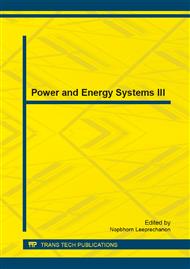[1]
YANG Hong-geng, XIAO Xian-yong, LIU Jun-yong. Issues and technology assessment on power quality Part 1: General concepts on power quality [J]. Electric Power Automation Equipment, 2003, 23(10): 1-4.
DOI: 10.1109/drpt.2004.1338065
Google Scholar
[2]
Lee G J, Albu M M, Heydt G T. A power quality index based on equipment sensitivity, cost, and network vulnerability[J]. Power Delivery, IEEE Transactions on, 2004, 19(3): 1504-1510.
DOI: 10.1109/tpwrd.2004.829124
Google Scholar
[3]
Martinez J A, Martin-Arnedo J. Voltage sag studies in distribution networks-part II: voltage sag assessment[J]. Power Delivery, IEEE Transactions on, 2006, 21(3): 1679-1688.
DOI: 10.1109/tpwrd.2006.874112
Google Scholar
[4]
Djokic S Z, Desmet J, Vanalme G, et al. Sensitivity of personal computers to voltage sags and short interruptions[J]. Power Delivery, IEEE Transactions on, 2005, 20(1): 375-383.
DOI: 10.1109/tpwrd.2004.837828
Google Scholar
[5]
WANG Hua-wei, LI Hua-qiang, XIAO Ling. Twofold Uncertainty Combination Based Probability Evaluation of Failures Occurred in Voltage Sensitive Equipments due to Voltage Sag [J]. Power System Technology, 2010, 34(4): 134-139.
Google Scholar
[6]
LIN Haixue. Voltage dip and short supply interruption in power system. Distribution & Utilization, 2002(1): 9-11, 13.
Google Scholar
[7]
PEI Xi-ping, HAO Xiao-hong, etc. A real-time detection method of the voltage sag characteristics based on symmetrical components estimation[J]. Power System Protection and Control, 2012, 40(11): 82-86.
Google Scholar
[8]
IEEE Recommended Practice for Evaluating Electric Power System Compatibility With Electronic Process Equipment, 1998. IEEE Std. 1346-(1998).
DOI: 10.1109/ieeestd.1998.87816
Google Scholar
[9]
Gupta C P, Milanovic J V. Probabilistic methods for counting equipment trips due to voltage sags[C]/Probabilistic Methods Applied to Power Systems, 2006. PMAPS 2006. International Conference on. IEEE, 2006: 1-8.
DOI: 10.1109/pmaps.2006.360306
Google Scholar
[10]
Gupta C P, Milanovic J V. Probabilistic assessment of equipment trips due to voltage sags[J]. Power Delivery, IEEE Transactions on, 2006, 21(2): 711-718.
DOI: 10.1109/tpwrd.2005.855447
Google Scholar
[11]
Milanovic J V, Gupta C P. Probabilistic assessment of financial losses due to interruptions and voltage sags-part I: the methodology[J]. Power Delivery, IEEE Transactions on, 2006, 21(2): 918-924.
DOI: 10.1109/tpwrd.2006.870988
Google Scholar
[12]
Milanovic J V, Gupta C P. Probabilistic assessment of financial losses due to interruptions and voltage sags-part II: practical implementation[J]. Power Delivery, IEEE Transactions on, 2006, 21(2): 925-932.
DOI: 10.1109/tpwrd.2006.870987
Google Scholar
[13]
Zhi W, XueJing L, Chen C, et al. A new method to achieve real-time detection and tracking of network voltage phase angle jumping under grid faults[C]/Advanced Power System Automation and Protection (APAP), 2011 International Conference on. IEEE, 2011, 1: 474-479.
DOI: 10.1109/apap.2011.6180449
Google Scholar


